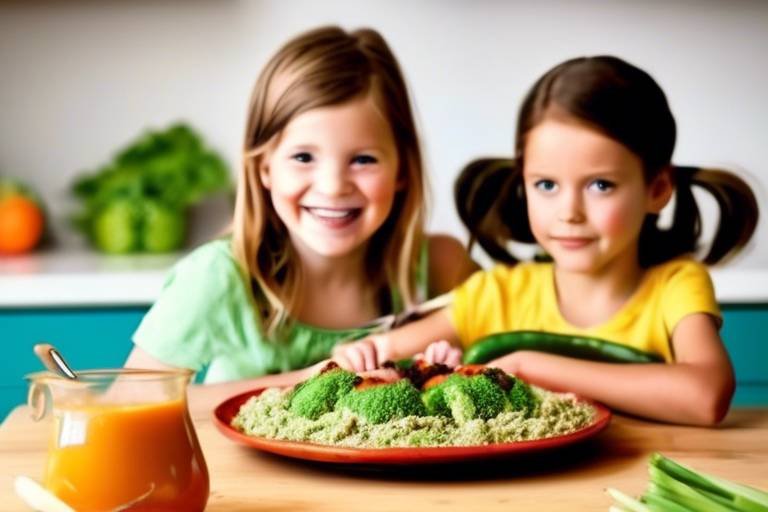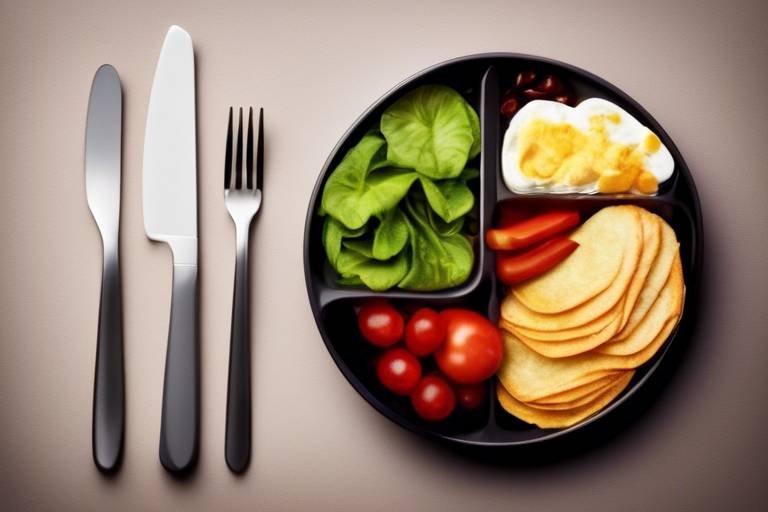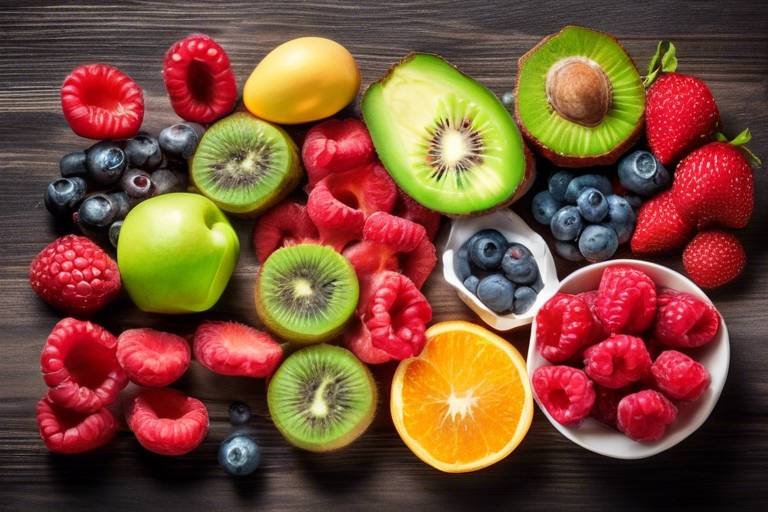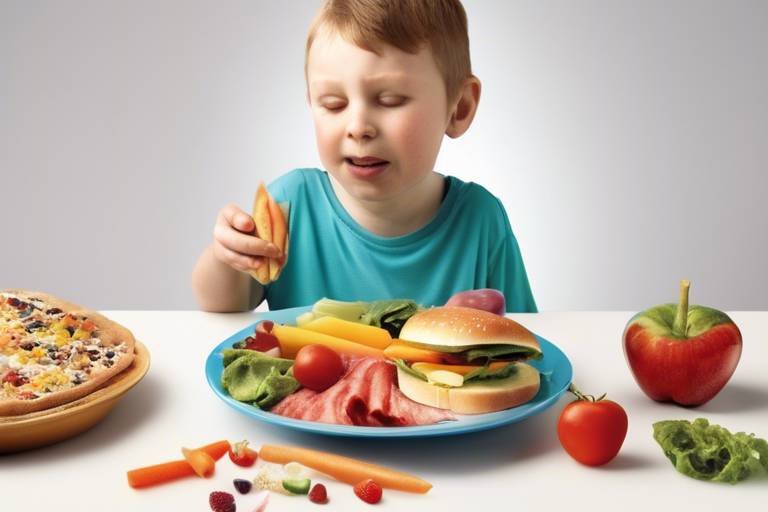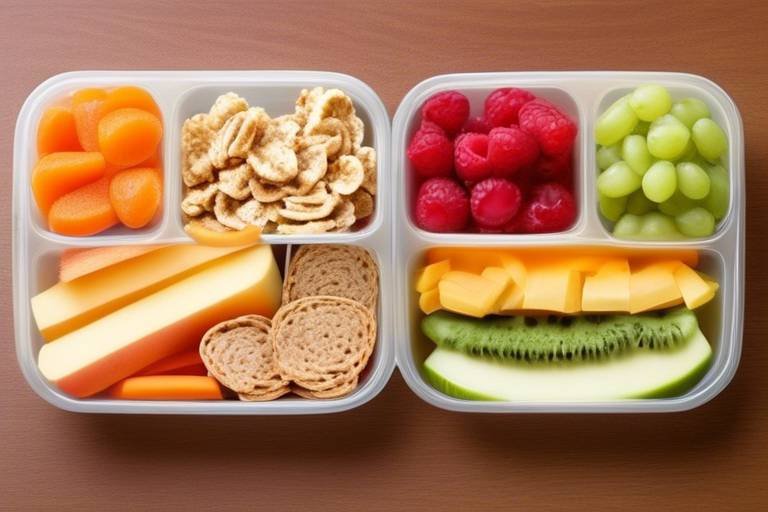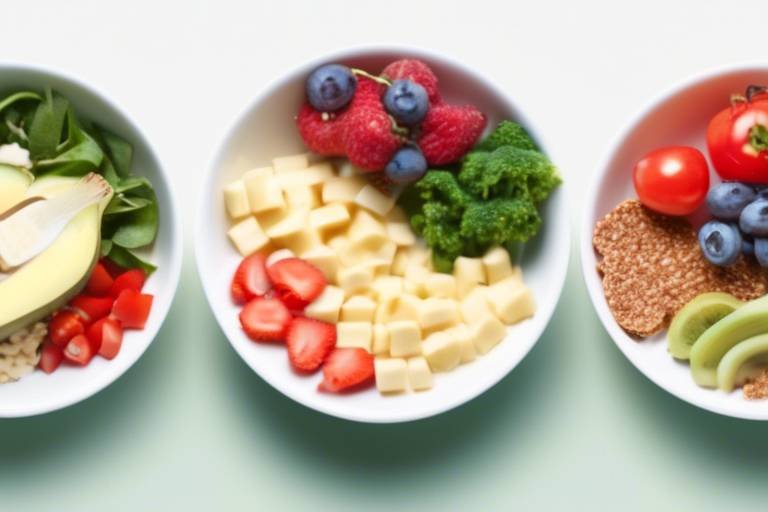Every Mom's Guide to Picking Healthy Snacks for Kids
As a mom, navigating the world of snacks can feel like a daunting task, especially when you want to ensure your kids are eating healthily. It's like being a ship captain steering through a sea of sugary treats and processed foods, trying to find that elusive island of nutritious options. But worry not! This article provides essential tips and insights for mothers on selecting nutritious snacks that appeal to children, ensuring they enjoy healthy eating habits while satisfying their taste buds. With a little creativity and knowledge, you can transform snack time from a guilty pleasure into an exciting opportunity for growth and nourishment.
First off, it’s crucial to understand what makes up a balanced diet for children. Kids have unique nutritional requirements that support their rapid growth and development. They need a variety of nutrients, including proteins, carbohydrates, healthy fats, vitamins, and minerals. Think of it as building a strong fortress; each nutrient acts as a brick that fortifies their health. By learning about these essential nutrients, you can make informed snack choices that cater to their dietary needs. For instance, snacks rich in calcium like yogurt or cheese can help strengthen bones, while iron-rich snacks like nuts and seeds support energy levels.
Now that we have a grasp on nutritional needs, let’s dive into some healthy snack options that are both nutritious and appealing to kids. The key is to provide tasty alternatives to processed snacks that often dominate the market. When you walk down the snack aisle, it can be overwhelming, but remember that nature has provided us with a treasure trove of healthy choices. Here are some categories to consider:
Fruits and vegetables are the superheroes of healthy snacking. They are packed with vitamins, minerals, and fiber, making them a perfect choice for kids. But how do you get your little ones excited about these healthy options? It’s all about presentation and creativity! You can turn ordinary fruits and veggies into fun and enticing snacks that promote healthy eating habits. For example, try making a colorful fruit salad with a mix of berries, bananas, and melon, or create a veggie platter with a rainbow of colors to entice even the pickiest of eaters.
Fruit-based snacks can be a delicious way to sneak in those essential vitamins. One popular option is smoothies, which are not only tasty but also incredibly versatile. You can blend fruits like bananas, strawberries, and spinach to create a nutrient-packed drink that feels like a treat. Another fun idea is to prepare fruit cups, layering different types of fruits in a clear cup, making it visually appealing for your kids. They’ll love the colorful combinations, and you’ll love the health benefits!
When it comes to vegetables, sometimes a little dip can go a long way. Hummus, yogurt-based dips, or guacamole can make veggies much more appealing. Carrot sticks, cucumber slices, and bell pepper strips paired with a tasty dip can turn snack time into a fun culinary adventure. You can even make baked veggie chips at home, using sweet potatoes or kale, giving your kids a crunchy snack that’s far healthier than store-bought chips.
Whole grains and nuts are another fantastic option for healthy snacking. Whole grain crackers or popcorn can provide the necessary fiber and energy to keep kids going throughout the day. Nuts, on the other hand, are packed with protein and healthy fats, making them a great choice for after-school snacks. Just remember to keep an eye on portion sizes, as nuts can be calorie-dense. You can create a fun trail mix by combining whole grain cereal, dried fruits, and a handful of nuts, turning snack time into a delightful mix of flavors and textures.
Now that we’ve covered healthy options, let’s talk about how to make these snacks exciting for kids. After all, if it doesn’t look fun, they might not want to eat it! One way to achieve this is through creative presentation. You can use cookie cutters to shape sandwiches or fruits into fun designs, or arrange snacks into smiley faces on their plates. The more visually appealing you make the snacks, the more likely your kids are to dive in.
Consider using vibrant colors and interesting shapes to catch their attention. For example, a fruit kabob with colorful chunks of pineapple, strawberries, and grapes can be a hit! Kids love food that they can hold and eat, so get creative with your presentations. You can even have themed snack days, like “Taco Tuesday” with healthy taco fillings wrapped in lettuce leaves.
Another fantastic way to encourage healthy eating is to involve your children in the snack-making process. When kids participate in preparing their snacks, they are more likely to try new foods and develop a positive relationship with healthy eating. You can set up a “snack station” with various healthy ingredients and let them create their own combinations. This not only makes it fun but also empowers them to make healthier choices.
Q: How can I encourage my child to eat more fruits and vegetables?
A: Start by making them accessible and fun! Keep cut-up fruits and veggies in the fridge for easy snacking, and involve your kids in choosing and preparing them. You can also try fun dips to make them more appealing.
Q: What are some quick healthy snacks I can prepare?
A: Some quick options include yogurt with granola, apple slices with peanut butter, or whole grain crackers with cheese. These snacks are not only healthy but also easy to prepare!
Q: Are store-bought healthy snacks a good option?
A: Yes, but it’s essential to read labels carefully. Look for snacks with whole ingredients, minimal added sugars, and no artificial preservatives. Homemade options are often the healthiest choice!

Understanding Nutritional Needs
When it comes to our little ones, understanding their nutritional needs is like having a secret recipe for success. Just like a car needs fuel to run, children require a variety of nutrients to support their rapid growth and development. It’s essential to ensure they’re getting the right balance of vitamins, minerals, proteins, fats, and carbohydrates. But what does that actually mean for snack time? Let’s break it down!
First off, children need a diet rich in fruits and vegetables. These colorful foods are packed with essential vitamins such as Vitamin C, which helps in boosting their immune system, and Vitamin A, crucial for vision and skin health. But it’s not just about the vitamins; the fiber found in fruits and vegetables aids digestion and keeps those little tummies feeling satisfied. Aim to fill half their plate with these vibrant options at every meal and snack.
Next, let’s talk about proteins. Proteins are the building blocks of the body, helping in growth and repair. Think of proteins as the bricks in a house; without them, the structure can’t stand strong. Good sources include lean meats, dairy, beans, and nuts. Incorporating protein into snacks can help keep kids feeling full and energized throughout the day.
Don’t forget about healthy fats, which are vital for brain development. Foods like avocados, olive oil, and nuts provide essential fatty acids that support cognitive function. It’s like giving their brains a boost of premium fuel! A little bit of fat can go a long way in making snacks more satisfying and tasty.
Lastly, we can’t overlook whole grains. Unlike their refined counterparts, whole grains retain their bran and germ, making them a richer source of fiber and nutrients. Whole grain snacks, like popcorn or whole grain crackers, not only provide energy but also help in maintaining steady blood sugar levels, keeping those energy crashes at bay.
To sum it up, here’s a quick overview of the essential nutrients children need:
| Nutrient | Importance | Sources |
|---|---|---|
| Vitamins | Boost immune system, support growth | Fruits, vegetables |
| Proteins | Growth and repair of body tissues | Lean meats, dairy, beans, nuts |
| Healthy Fats | Brain development | Avocados, olive oil, nuts |
| Whole Grains | Energy and digestive health | Whole grain bread, popcorn, oats |
Understanding these nutritional needs is crucial for moms aiming to create a healthy snacking environment. By being aware of what their children need, mothers can make informed decisions that not only satisfy their kids' taste buds but also promote a lifetime of healthy eating habits. So, the next time you’re at the store, think about filling your cart with these nutrient-rich options, because healthy snacking is the first step towards a well-nourished child!
- What are some quick healthy snacks for kids?
Some quick options include yogurt with fruit, whole grain crackers with cheese, and cut-up veggies with hummus.
- How can I get my kids to eat more vegetables?
Try involving them in the cooking process or presenting veggies in fun shapes and colors to make them more appealing.
- Are store-bought snacks healthy?
Many store-bought snacks can be high in sugar and preservatives. Always check the labels for whole ingredients and minimal additives.

Identifying Healthy Snack Options
When it comes to selecting healthy snacks for kids, it can feel like navigating a maze filled with tempting but unhealthy options. As a mom, you want to ensure that your little ones are munching on snacks that not only satisfy their cravings but also provide them with the nutrition they need to thrive. The good news is that there are plenty of nutritious and delicious snack options out there that can make your life easier and your child's diet healthier.
First off, let’s talk about the importance of whole foods. These are foods that are minimally processed and free from artificial ingredients, making them the best choice for your kids. Think of fruits, vegetables, whole grains, and nuts as your go-to snack staples. They are packed with essential vitamins and minerals that are crucial for your child's growth and development. But what exactly can you offer that’s both healthy and appealing? Let’s dive into some ideas!
One of the easiest ways to start is by incorporating a variety of fruits and vegetables into your child's snack routine. Not only are they rich in nutrients, but they can also be incredibly fun to eat. For instance, you can create a colorful fruit salad with a mix of berries, bananas, and apples. You might even consider making fruit skewers, which can turn an ordinary snack into a fun, interactive experience. Additionally, vegetables can be just as exciting. Carrot sticks, cucumber slices, and bell pepper strips can be served with a tasty dip, making them more appealing to picky eaters.
Fruit-based snacks are not just healthy; they can also be a treat that kids look forward to! Smoothies are a fantastic option. You can blend together their favorite fruits with yogurt or milk to create a creamy, delicious drink. This not only tastes great but also provides a good dose of calcium and vitamins. Another idea is making homemade fruit cups. Simply chop up a variety of fruits and store them in the fridge for a quick snack that’s ready to go. Kids love the vibrant colors and flavors, and you’ll love knowing they’re getting their daily servings of fruit!
Now, let’s not forget about vegetables! To make these green goodies more enticing, consider preparing veggie dips. Hummus, guacamole, or yogurt-based dips can turn plain veggies into a crunchy, delicious snack. You could also make baked veggie chips from kale, sweet potatoes, or zucchini. These homemade chips are not only healthier than store-bought options but also allow you to control the seasoning.
Another great option is to create a snack platter that combines a variety of healthy snacks. You can include whole grain crackers, cheese slices, nuts, and a selection of fruits and veggies. This not only provides a balanced snack but also gives kids the freedom to choose what they want to eat, making them more likely to enjoy their food. Remember, variety is key to keeping snack time exciting and nutritious!
In conclusion, identifying healthy snack options for your kids doesn’t have to be a daunting task. By focusing on whole foods and getting creative in the kitchen, you can provide snacks that are both nutritious and appealing. The next time you’re in the snack aisle, think outside the box and opt for wholesome ingredients that your kids will love!
- What are some quick healthy snacks for kids?
Some quick options include yogurt with fruit, whole grain crackers with cheese, or a handful of nuts.
- How can I encourage my kids to eat more fruits and vegetables?
Get them involved in the snack preparation process and present the snacks in fun and colorful ways.
- Are store-bought snacks ever healthy?
Yes, some store-bought snacks can be healthy, but it's essential to read the labels and look for options with minimal ingredients and no added sugars.

Fruits and Vegetables
When it comes to healthy snacking, fruits and vegetables are truly the superheroes of the food world. Packed with essential vitamins, minerals, and fiber, they not only nourish your child but also satisfy their taste buds. Imagine a vibrant rainbow of fruits and veggies on your kitchen table, each color representing a different nutrient that your little ones need to grow strong and healthy. But how do you make these nutritious options appealing to kids who might prefer the allure of sugary snacks?
First, let's talk about fruits. They can be a delightful treat when presented in fun and engaging ways. For instance, you can create colorful fruit skewers by threading pieces of various fruits onto wooden sticks. This not only makes the snack visually appealing but also adds an element of fun. You can also prepare smoothies that blend fruits with yogurt or milk, creating a creamy, delicious drink that kids will love. Try mixing bananas, strawberries, and a splash of orange juice for a refreshing blast of flavor. The best part? You can sneak in some spinach or kale without them even noticing!
Now, let’s not forget about the power of vegetables. While they may not always get the same love as fruits, there are plenty of creative ways to make them exciting. One effective method is to serve veggies with dips. Hummus, yogurt-based dips, or even guacamole can turn a simple carrot stick or cucumber slice into a tasty treat. You can also bake thin slices of sweet potatoes or zucchini to make veggie chips. These crunchy alternatives to traditional chips are not only healthier but also fun to munch on while watching a movie or playing games.
Incorporating a variety of fruits and vegetables into your child's diet can also be a fun adventure. Consider making a weekly fruit and veggie challenge where each week, you introduce a new fruit or vegetable. You can keep track of their favorites and even involve your kids in the grocery shopping process. This not only teaches them about healthy eating but also gives them a sense of ownership over their food choices.
To give you a clearer idea of how to incorporate fruits and veggies into snacks, here’s a quick comparison table of some popular options:
| Snack | Benefits | Kid-Friendly Tip |
|---|---|---|
| Fruit Skewers | High in vitamins, low in calories | Let kids choose their favorite fruits to include |
| Smoothies | Rich in nutrients and easy to digest | Add a fun straw to make it exciting |
| Veggie Chips | Low in fat, high in fiber | Serve with a tasty dip |
| Veggie Dips | Encourages vegetable consumption | Make it a colorful platter |
By turning fruits and vegetables into fun and engaging snacks, you can help your children develop a love for healthy eating. Remember, it's all about creativity and presentation. When kids see their snacks as a fun experience rather than a chore, they’re more likely to embrace these nutritious options. So, roll up your sleeves, get creative, and watch as your kids dive into a world of healthy snacking!
- How can I encourage my kids to try new fruits and vegetables? Involve them in the selection process at the grocery store and make it a fun challenge to try one new fruit or vegetable each week.
- What are some easy fruit snack ideas? Fruit skewers, smoothies, and fruit cups are all simple and fun ways to serve fruit.
- How can I make vegetables more appealing? Serve them with dips, create veggie chips, or present them in fun shapes using cookie cutters.

Fruit-Based Snacks
When it comes to healthy snacking, are a fantastic option that not only provide essential nutrients but also satisfy a child's sweet tooth. Fruits are nature's candy, bursting with flavor and packed with vitamins, minerals, and fiber. Imagine biting into a juicy apple or a ripe banana—doesn’t that sound refreshing? The beauty of fruit-based snacks is their versatility. You can prepare them in countless ways, making them appealing to even the pickiest of eaters.
One of the easiest and most fun ways to incorporate fruits into your child's diet is through smoothies. You can blend a variety of fruits such as bananas, berries, and mangoes with yogurt or milk to create a creamy, delicious treat. Not only are smoothies easy to make, but they also allow you to sneak in some greens like spinach or kale without your child even noticing! Just think of it as a colorful potion that gives them superhero powers.
Another delightful option is to create fruit cups. You can chop up seasonal fruits and mix them in a colorful bowl, making it visually appealing. Add a drizzle of honey or a sprinkle of cinnamon for an extra touch of sweetness. These fruit cups can be a great addition to lunch boxes or an afternoon snack. You might even encourage your little ones to get creative by letting them choose their favorite fruits to include!
Don't forget about fruit skewers. These are not only fun to eat but also allow for a hands-on experience. Simply thread pieces of various fruits onto skewers and let your kids enjoy their fruity kebabs. You can even pair them with a yogurt dip for added flavor. It's like a party on a stick!
For those days when you have a bit more time, consider baking some fruit-based treats. How about making banana bread or apple muffins? These can be made healthier by substituting refined flour with whole grain flour and reducing sugar. Plus, you can sneak in some nuts or seeds for added nutrition. Your kids will love the aroma wafting through the kitchen, and they’ll be excited to taste the fruits of your labor!
Incorporating fruits into snacks doesn’t have to be a chore. It can be a fun and engaging activity that encourages your children to explore different flavors and textures. By presenting fruits in creative ways, you can help foster a love for healthy eating that lasts a lifetime. So, get ready to embark on a fruity adventure with your kids, and watch as they delight in their new favorite snacks!
- What are some easy fruit-based snacks for kids? Simple options include smoothies, fruit cups, and fruit skewers.
- Can I use frozen fruits for snacks? Absolutely! Frozen fruits are just as nutritious and can be used in smoothies or as toppings for yogurt.
- How can I make fruit snacks more appealing? Try using fun shapes, colorful presentations, or pairing fruits with dips like yogurt or nut butter.

Veggie Dips and Chips
When it comes to getting kids to eat their vegetables, the key often lies in making them fun and tasty. One of the most effective ways to do this is by pairing fresh veggies with delicious dips. Imagine a colorful platter of crunchy carrots, crisp cucumber slices, and vibrant bell peppers, all ready to be dunked into a creamy, flavorful dip. Not only does this presentation make veggies more appealing, but it also transforms snack time into a delightful experience for your little ones.
There are countless options for dips that can elevate the humble vegetable into a superstar snack. From classic ranch dressing to hummus, the choices are endless. Here’s a quick look at some popular veggie dips:
| Dip | Main Ingredients | Flavor Profile |
|---|---|---|
| Ranch Dressing | Sour cream, buttermilk, herbs | Creamy, tangy |
| Hummus | Chickpeas, tahini, garlic | Nutty, savory |
| Guacamole | Avocado, lime, cilantro | Rich, zesty |
| Spinach Dip | Spinach, cream cheese, sour cream | Rich, creamy |
To make the experience even more enjoyable, consider creating a DIY Veggie Bar at home. Lay out various vegetables along with a selection of dips, and let your kids choose what they want to try. This not only gives them a sense of control over their snack choices but also encourages them to experiment with different flavors and textures. You might be surprised at how willing they are to try something new when they can customize their snack!
Another fun idea is to make veggie chips. Baked or air-fried veggie chips can be a crunchy alternative to traditional potato chips. Think about using kale, zucchini, or sweet potatoes. Simply slice them thin, toss them with a bit of olive oil and your favorite spices, and bake until crispy. These chips are not only delicious but also packed with nutrients, making them a guilt-free option for snack time.
Incorporating veggie dips and chips into your child's diet can significantly enhance their vegetable intake while keeping snack time enjoyable. By presenting these nutritious options in a fun and engaging way, you're not just feeding their bodies; you're also nurturing their love for healthy eating habits. Remember, the more colorful and creative you can be, the more likely your kids are to dive in and enjoy!
- What are some easy dips I can make at home? You can whip up simple dips like hummus, guacamole, or a yogurt-based ranch dressing with minimal ingredients.
- Are veggie chips healthier than regular chips? Yes! Veggie chips are typically lower in calories and fat, and they offer more nutrients than traditional potato chips.
- How can I encourage my picky eater to try vegetables? Involve them in the snack preparation process, and present the veggies in fun shapes or with exciting dips to make them more appealing.

Whole Grains and Nuts
When it comes to healthy snacking for kids, are like the dynamic duo of nutrition! They are packed with energy and essential nutrients that can keep your little ones fueled and focused throughout the day. Whole grains, such as oats, brown rice, and whole wheat bread, are rich in fiber, which is crucial for digestion and helps keep kids feeling full longer. Now, you might be wondering, why is fiber so important? Well, think of it as the superhero that keeps your child's digestive system running smoothly, preventing those pesky tummy aches that can interrupt their playtime.
Nuts, on the other hand, are tiny powerhouses of protein, healthy fats, and vitamins. They not only provide energy but also support brain health, which is vital for growing minds. Just imagine your child's brain lighting up like a Christmas tree after munching on some almonds or walnuts! However, it’s essential to keep in mind that nuts can be a choking hazard for younger children, so always opt for nut butters or finely chopped nuts for the little ones.
To make it easier for you to understand the benefits of whole grains and nuts, here’s a quick comparison table that highlights some popular options and their nutritional perks:
| Food Item | Nutritional Benefits |
|---|---|
| Oats | High in fiber, keeps kids full, great for heart health |
| Brown Rice | Rich in vitamins and minerals, provides long-lasting energy |
| Whole Wheat Bread | Full of fiber, helps in digestion, keeps blood sugar stable |
| Almonds | High in protein, healthy fats, and vitamin E for brain health |
| Walnuts | Rich in omega-3 fatty acids, supports cognitive function |
Incorporating these foods into your child's diet can be as easy as pie! Try making overnight oats for breakfast or a quick snack. Just combine rolled oats with milk or yogurt, add some fruits or a dollop of nut butter, and let it sit overnight. In the morning, you’ll have a delicious and nutritious treat ready to go! Similarly, you can whip up some nut butter sandwiches using whole grain bread and your child's favorite nut butter. It’s a simple yet satisfying snack that will keep them energized and ready for their next adventure.
Don't forget the importance of variety! Kids can be picky eaters, so presenting these wholesome snacks in different forms can make a world of difference. For instance, you can create a fun trail mix by combining whole grain cereal, nuts, and some dried fruits. This not only adds a burst of flavor but also makes snacking an exciting activity. Who wouldn’t want to dive into a colorful, crunchy mix?
So, next time you’re at the grocery store, remember to stock up on whole grains and nuts. They’re not just good for your kids; they’re a smart choice for the whole family. With these nutritious options in hand, you’ll be well on your way to transforming snack time into a healthy and enjoyable experience!

Making Snacks Fun
Snack time doesn't have to be a mundane routine; it can be a delightful adventure for both you and your kids! When you turn healthy snacks into a fun experience, you’re not just feeding them; you’re creating lasting memories. Imagine snack time as a mini celebration where every bite is a reason to smile. So, how can you make this happen?
First off, let’s talk about creative presentation. Kids are naturally drawn to vibrant colors and interesting shapes. Instead of just placing a plain apple on the table, why not slice it into fun shapes using cookie cutters? You could create a rainbow of fruits on a plate, or even make a fruit kebab! This not only makes the food visually appealing but also encourages kids to try new things. When they see their favorite fruits arranged like a work of art, they are more likely to dive in.
Another fantastic way to jazz up snack time is by involving your little ones in the preparation process. Kids love to feel included, and when they help make their snacks, they are much more likely to eat them. You could set up a snack station where they can choose their ingredients. For example, let them pick their favorite fruits, nuts, and yogurt to create their own parfaits. This not only makes them excited about their food but also teaches them about healthy choices.
Additionally, consider making snacks into themed events. For instance, you could have a “Taco Tuesday” with healthy toppings like black beans, corn, and guacamole, or a “Fruit Friday” where every week you try a new fruit. This builds anticipation and gives them something to look forward to. You could even create a chart to track the different snacks they’ve tried, turning it into a fun game!
Lastly, don’t underestimate the power of storytelling. Turn your snacks into characters or heroes in a story. For example, if you’re serving carrot sticks, you could say they are “Super Crunchy Carrots” that give them superhero strength! This sparks their imagination and makes healthy eating more exciting. You could even create a fun storybook together about their snack adventures, making it a delightful blend of creativity and nutrition.
In conclusion, making snacks fun is all about creativity, involvement, and a dash of imagination. By transforming the way you present and prepare snacks, you can encourage your children to embrace healthy eating habits while enjoying the process. Remember, the goal is to create a positive experience around food that they will carry with them into adulthood.
- How can I get my kids to try new snacks? Involve them in the preparation and presentation process, and make it a fun activity!
- What are some easy healthy snacks to prepare? Fruit kebabs, yogurt parfaits, and veggie dips are simple and nutritious options.
- How can I make vegetables more appealing? Use dips, fun shapes, and engage kids in the cooking process to make them more enticing.

Creative Presentation
When it comes to enticing kids to eat healthy snacks, presentation is key. Think about it: would you rather eat a plain apple or one that’s been sliced and arranged into a fun shape? Exactly! Kids are naturally drawn to colorful and creatively presented foods, so why not use this to your advantage? By transforming ordinary snacks into visually appealing creations, you can spark their interest and make healthy eating a delightful experience.
One effective way to enhance presentation is by using fun shapes and colors. For example, you can use cookie cutters to create star-shaped sandwiches or fruit. Imagine a plate filled with star-shaped watermelon, heart-shaped strawberries, and flower-shaped cucumber slices! This not only makes the food more exciting but also encourages kids to try new fruits and veggies. You can even involve your little ones in the process—let them pick their favorite shapes and colors. This way, they’ll feel a sense of ownership over their meals, making them more likely to eat what’s on their plate.
Another great idea is to create themed snack plates. For instance, if your child loves dinosaurs, you could arrange their snacks in a way that resembles a dinosaur landscape. Use broccoli florets as trees, hummus as a pond, and cut-up carrots as “dinosaur paths.” Not only does this make snack time more fun, but it also encourages imaginative play, allowing kids to engage with their food in a creative way. Plus, it’s an excellent opportunity to talk about different themes—like space, under the sea, or even their favorite movie characters—while enjoying a healthy snack.
Don’t forget about colorful dips! Pairing fruits and veggies with vibrant dips can make all the difference. Think of a rainbow of colors on a plate: bright red salsa, sunny yellow hummus, and green guacamole. The contrast not only looks appealing but also provides a variety of flavors and nutrients. You can even create a “dipping station” where kids can mix and match their favorite snacks with different dips. This interactive approach can make snack time feel like a fun activity rather than a chore.
Lastly, consider using fun serving dishes. Instead of the usual plates, try using mini skewers for fruit kabobs or colorful bento boxes for a variety of snacks. These little changes can turn an ordinary snack into an extraordinary one. Kids love to eat with their hands, and skewers or bite-sized pieces can make the experience more enjoyable. Plus, bento boxes allow for portion control while still offering a variety of healthy options, making it easier for you to provide balanced snacks.
In summary, when it comes to making healthy snacks appealing to kids, a little creativity goes a long way. By focusing on presentation, using fun shapes, creating themed plates, incorporating colorful dips, and choosing playful serving dishes, you can turn snack time into an exciting adventure. Remember, the goal is to make healthy eating an enjoyable and engaging experience that they will look forward to every day!
- What are some quick healthy snacks for kids? Quick options include yogurt with fruit, whole grain crackers with cheese, or sliced veggies with hummus.
- How can I encourage my child to try new snacks? Involve them in the preparation process and make the presentation fun and appealing!
- Are store-bought snacks healthy? Some can be healthy, but always check the labels for added sugars and preservatives.

Involving Kids in Snack Preparation
When it comes to encouraging healthy eating habits in children, one of the most effective strategies is to involve them in the snack preparation process. Imagine this: your little ones, excitedly helping you in the kitchen, mixing ingredients, and creating their own snack masterpieces. Not only does this foster a sense of independence, but it also allows them to take ownership of their food choices. By engaging kids in cooking, you’re not just making snacks; you’re building a foundation for a lifetime of healthy eating.
So, how can you make this experience fun and educational? Start by letting them choose from a selection of healthy ingredients. For instance, you could lay out a variety of fruits, veggies, whole grains, and nuts, and let them pick what they want to include in their snacks. This not only gives them a sense of control but also encourages them to be adventurous with their food. You might be surprised at how willing they are to try new things when they’ve had a hand in creating them!
Here are a few engaging activities you can do together:
- Fruit Kabobs: Provide a selection of colorful fruits and let your kids assemble their own fruit kabobs. This activity is not only fun but also a great way to introduce them to different fruits.
- DIY Trail Mix: Set up a trail mix station with various nuts, seeds, and dried fruits. Allow your children to mix and match their favorites, creating a personalized snack that they’ll be excited to eat.
- Veggie Faces: Use sliced veggies and dips to create fun faces on a plate. This playful presentation can make healthy eating more appealing to picky eaters.
Moreover, teaching kids about the nutritional benefits of the ingredients they’re using can be a fantastic learning opportunity. For instance, you can explain how fruits provide essential vitamins and how nuts are packed with protein. This knowledge can empower them to make healthier choices in the future. Plus, it’s a great way to bond and create lasting memories in the kitchen together.
Involving kids in snack preparation can transform the way they view healthy foods. When they see the effort that goes into making their snacks, they are more likely to appreciate and enjoy them. So, roll up your sleeves, put on some aprons, and get ready for a fun-filled culinary adventure that will not only satisfy their taste buds but also instill lifelong healthy eating habits!
Q: How can I get my child interested in cooking?
A: Start with simple recipes that allow them to be hands-on. Let them choose ingredients and make decisions during the cooking process to spark their interest.
Q: What are some easy snacks to prepare with kids?
A: Some easy snacks include fruit kabobs, yogurt parfaits, and homemade trail mix. These snacks are simple to make and allow for creativity!
Q: How do I handle picky eaters during snack preparation?
A: Involve them in the process and let them choose from a selection of healthy options. Making food fun and visually appealing can also help entice them to try new things.
Frequently Asked Questions
- What are some healthy snack options for kids?
When it comes to healthy snacks for kids, think of colorful fruits and crunchy vegetables! You can offer sliced apples with peanut butter, carrot sticks with hummus, or yogurt with berries. Whole grain crackers or popcorn are also great choices that kids usually love!
- How can I make vegetables more appealing to my child?
Making veggies fun can be a game-changer! Try creating veggie dips with yogurt or hummus, or slice vegetables into fun shapes using cookie cutters. You can also pair them with a tasty dip to make them more enticing. Presentation matters, so get creative!
- Are fruit-based snacks healthy?
Absolutely! Fruit-based snacks are packed with vitamins and minerals. Smoothies made with yogurt and fresh fruit can be both nutritious and delicious. Homemade fruit cups or frozen fruit pops are also fantastic options that kids will enjoy.
- How can I involve my kids in snack preparation?
Involving kids in the kitchen is a fun way to spark their interest in healthy eating! Let them help wash fruits and vegetables, mix ingredients, or even assemble their own snacks. This hands-on experience can make them more likely to try new foods!
- What are the benefits of whole grains and nuts?
Whole grains and nuts provide essential nutrients and energy that kids need throughout the day. They are rich in fiber, which helps with digestion, and healthy fats that support brain development. Try whole grain bread, nut butter, or trail mix for a wholesome snack!
- How can I make snack time more fun?
Snack time doesn't have to be boring! You can create a “snack art” session where kids make pictures with their food. Use colorful fruits and veggies to create faces or animals. Adding a theme to snack time can also make it more engaging and enjoyable.



